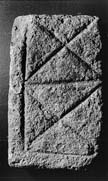Select a site alphabetically from the choices shown in the box below. Alternatively, browse sculptural examples using the Forward/Back buttons.
Chapters for this volume, along with copies of original in-text images, are available here.
Object type: Part of grave-marker
Measurements: L.31 cm (12.2 in) W. 19 cm (7.5 in) D. 7.5 cm (3 in)
Stone type: [Barnack Rag type, Upper Lincolnshire Limestone, Inferior Oolite Group]
Plate numbers in printed volume: Ills. 49–52
Corpus volume reference: Vol 5 p. 109
(There may be more views or larger images available for this item. Click on the thumbnail image to view.)
A small fragment from the corner of an upright rectangular grave-marker decorated on both broad faces with similar if not identical designs. The stone has been carefully cut for reuse.
A and C (broad): The field was divided into a series of square boxes by simply incised lines. Within the two boxes on each face of the surviving fragment is placed a simple incised cross saltire. It is uncertain how the remainder of the original faces would have been decorated. The cross saltires could have formed a border along one edge of either face or alternatively could have filled the whole field.
B (narrow) and E (top): The edge of the marker, which survives on two adjacent sides, is of rectangular section and undecorated.
The grave-marker represented by this stone was of similar size and type to those at Ancaster (Ill. 10), Swarby (Ills. 356–7) and Wilsford (no. 2, Ills. 390–1). It is decorated with the same simplified incised decoration and clearly belongs to the same large group of grave-markers, here called 'gridded' markers, produced in at least three centres in the late tenth and eleventh centuries (Chapter V, Table 7C). The marker at Bicker, like that at Gosberton (Ill. 175), is made of a shelly ragstone from the Barnack area (and not from the even-grained oolite from Ancaster); and at Barnack church itself it finds a very close parallel. Bicker 4 presumably, therefore, arrived at Bicker by water, having been carried the short distance down the Welland.



